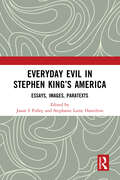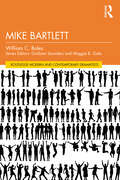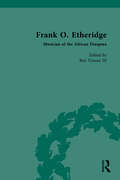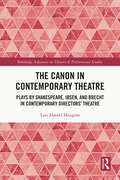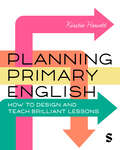- Table View
- List View
Culture Wars in American Education: Past and Present Struggles Over the Symbolic Order (Critical Social Thought)
by Michael R. OlneckCulture Wars in American Education: Past and Present Struggles Over the Symbolic Order radically questions norms and values held within US Education and analyses why and how culture wars in American education are intense, consequential, and recurrent.Applying the concept of “symbolic order,” this volume elaborates ways in which symbolic representations are used to draw boundaries, allocate status, and legitimate the exercise of authority and power within American schooling. In particular, the book illustrates the “terms of inclusion” by which full membership in the national community is defined, limited, and contested. It suggests that repetitive patterns in the symbolic order, for example, the persistence of the representation of an individualistic basis of American society and polity, constrain the reach of progressive change. The book examines the World War I era Americanization movement, the World War II era Intercultural Education movement, the late-twentieth-century Multicultural Education movement, continuing right-wing assaults on Ethnic Studies and Critical Race Theory in the first decades of the twenty-first century, and historical and contemporary conflicts over the incorporation of languages other than Standard English into approved instructional approaches.In the context of continuing culture wars in the United States and across the globe, this book will be of interest to graduate students and scholars in critical studies of education, history of education, sociology of education, curriculum theory, Multicultural Education, and comparative education, as well as to educators enmeshed in contemporary tensions and conflicts.
Researching Educational Practices, Teacher Education and Professional Development for Early Language Learning: Examples from Europe (Routledge Research in Language Education)
Recognising the urgent need for further progress in teacher education and preparation for the success of early language learning, this volume presents research on the education and professional development of teachers, exploring how they can foster multilingual spaces in the early years of formal education.Investigating a range of European contexts, the book examines the effectiveness of teacher education for early language learning, covering contexts of multilingualism and English as a foreign language (EFL) with children under the age of 12. Split into three parts examining research into teacher practices, education, and curricula, chapters cover emerging topics such as teacher education and local linguistic encounters; global citizenship and transcultural education; linguistic landscapes and visual narratives; mixed-age classrooms and literacy skills; pre-service and in-service teacher education; and teacher and teacher educator competencies and beliefs.Offering a unique combination of foci on teachers, teacher education and classroom practice, this book will be of great interest to researchers and postgraduate students in the fields of early language education, multilingualism, EFL and teacher education more broadly. Student teachers and teachers working in early language learning contexts may also find the volume of interest.
Translation and the Borders of Contemporary Japanese Literature: Inciting Difference (Routledge Contemporary Japan Series)
by Victoria YoungThis book examines contemporary debates on such concepts as national literature, world literature, and the relationship each of these to translation, from the perspective of modern Japanese fiction.By reading between the gaps and revealing tensions and blind spots in the image that Japanese literature presents to the world, the author brings together a series of essays and works of fiction that are normally kept separate in distinct subgenres, such as Okinawan literature, zainichi literature written by ethnic Koreans, and other “trans-border” works. The act of translation is reimagined in figurative, expanded, and even disruptive ways with a focus on marginal spaces and trans-border movements. The result decentres the common image of Japanese literature while creating connections to wider questions of multilingualism, decolonisation, historical revisionism, and trauma that are so central to contemporary literary studies.This book will be of interest to all those who study modern Japan and Japanese literature, as well as those working in the wider field of translation studies, as it subjects the concept of world literature to searching analysis.
Translation and the Borders of Contemporary Japanese Literature: Inciting Difference (Routledge Contemporary Japan Series)
by Victoria YoungThis book examines contemporary debates on such concepts as national literature, world literature, and the relationship each of these to translation, from the perspective of modern Japanese fiction.By reading between the gaps and revealing tensions and blind spots in the image that Japanese literature presents to the world, the author brings together a series of essays and works of fiction that are normally kept separate in distinct subgenres, such as Okinawan literature, zainichi literature written by ethnic Koreans, and other “trans-border” works. The act of translation is reimagined in figurative, expanded, and even disruptive ways with a focus on marginal spaces and trans-border movements. The result decentres the common image of Japanese literature while creating connections to wider questions of multilingualism, decolonisation, historical revisionism, and trauma that are so central to contemporary literary studies.This book will be of interest to all those who study modern Japan and Japanese literature, as well as those working in the wider field of translation studies, as it subjects the concept of world literature to searching analysis.
Everyday Evil in Stephen King's America: Essays, Images, Paratexts
This edited collection variously interrogates how everyday evil manifests in Stephen King’s now-familiar American imaginary; an imaginary that increases the representational limits of both anticipated and experienced realism. Divided into three parts: I. The Man, II. The Monster, and III. The Re-mediator, the book offers rigorous readings of evil, realism, and popular culture as represented in a range of texts (and paratexts) from the King canon. Rich with images, a photo-essay, and appendices collecting classical texts and cultural detritus germane to King, this book moves away from viewing King’s work primarily through the lens of the “American gothic” and toward the realism that the suspense novelist’s voice (fictional and non-) and influence (literary and popular) indelibly continue to amplify, all the while complicating the traditional divide between serious literature and popular fiction.Stephen King remains perpetually popular. And he is finally receiving the academic treatment he has craved since the early 1980s. Yet still unexamined in the King critical canon is the suspense novelist’s fascination with “everyday evil.” Beyond rigorous interrogations of King’s fictional depictions of “everyday evil” by an array of scholars of different ranks living around the world (Canada, Finland, Hong Kong, the UK), the book, replete with 20 images, considers how King widens the parameters of literary production and appreciation. An integral part of the Americana that King’s five-decades-in-the-making canon configures, of course, includes King himself. King has long made use of self-referentiality in his fiction and nonfiction. Some of his nonfiction, several of our essays reveal, recirculates in paratextual form as “Prefatory Remarks” to new novels or new editions of older ones. The paratexts considered here (both across the volume and in the appendices) offer alternate ways by which to appreciate King and his sphere of influence (literary and popular). Said appendices are a grouping of King's paratexts on his writing as Bachman, appearing here, for the first time, as a cohesive collection. King's influence took off in the 1970s, as is further explored in the book-enveloping three-part photo-essay “King’s America, America’s King: Stephen King & Popular Culture since the 1970s.” About the transformative quality of “everyday evil,” the photo-essay tracks the cultural impacts of King first as an emerging author, then a pop culture phenomenon, and, finally, as an established American literary voice.Everyday Evil in Stephen King's America is designed to appeal to teachers and students of American literature, to Stephen King enthusiasts, as well as to acolytes of Americana since the Vietnam War.
Everyday Evil in Stephen King's America: Essays, Images, Paratexts
by Jason S Polley Stephanie Laine HamiltonThis edited collection variously interrogates how everyday evil manifests in Stephen King’s now-familiar American imaginary; an imaginary that increases the representational limits of both anticipated and experienced realism. Divided into three parts: I. The Man, II. The Monster, and III. The Re-mediator, the book offers rigorous readings of evil, realism, and popular culture as represented in a range of texts (and paratexts) from the King canon. Rich with images, a photo-essay, and appendices collecting classical texts and cultural detritus germane to King, this book moves away from viewing King’s work primarily through the lens of the “American gothic” and toward the realism that the suspense novelist’s voice (fictional and non-) and influence (literary and popular) indelibly continue to amplify, all the while complicating the traditional divide between serious literature and popular fiction.Stephen King remains perpetually popular. And he is finally receiving the academic treatment he has craved since the early 1980s. Yet still unexamined in the King critical canon is the suspense novelist’s fascination with “everyday evil.” Beyond rigorous interrogations of King’s fictional depictions of “everyday evil” by an array of scholars of different ranks living around the world (Canada, Finland, Hong Kong, the UK), the book, replete with 20 images, considers how King widens the parameters of literary production and appreciation. An integral part of the Americana that King’s five-decades-in-the-making canon configures, of course, includes King himself. King has long made use of self-referentiality in his fiction and nonfiction. Some of his nonfiction, several of our essays reveal, recirculates in paratextual form as “Prefatory Remarks” to new novels or new editions of older ones. The paratexts considered here (both across the volume and in the appendices) offer alternate ways by which to appreciate King and his sphere of influence (literary and popular). Said appendices are a grouping of King's paratexts on his writing as Bachman, appearing here, for the first time, as a cohesive collection. King's influence took off in the 1970s, as is further explored in the book-enveloping three-part photo-essay “King’s America, America’s King: Stephen King & Popular Culture since the 1970s.” About the transformative quality of “everyday evil,” the photo-essay tracks the cultural impacts of King first as an emerging author, then a pop culture phenomenon, and, finally, as an established American literary voice.Everyday Evil in Stephen King's America is designed to appeal to teachers and students of American literature, to Stephen King enthusiasts, as well as to acolytes of Americana since the Vietnam War.
Family and Artistic Relations in Polish Women’s Autobiographical Literature (ISSN)
by Aleksandra GrzemskaFamily and Artistic Relations in Polish Women’s Autobiographical Literature examines women’s autobiographical works published in Poland after the year 2000 in a broader cultural context. This volume focuses on the writers’ representation of their relationships with their mothers – many of them traumatized survivors of historical cataclysms, many of them professional artists, many of them struggling to reconcile their creative work with their role as wife and mother. Grzemska sheds light not only on the literary strategies used by the memoirists, but she also helps us understand women’s struggles for an independent voice, for new models of commemoration, for healing. This book will interest readers in literary and cultural studies, as well as anyone who wishes to better understand Poland’s cultural transformations in the post-Communist era.
Family and Artistic Relations in Polish Women’s Autobiographical Literature (ISSN)
by Aleksandra GrzemskaFamily and Artistic Relations in Polish Women’s Autobiographical Literature examines women’s autobiographical works published in Poland after the year 2000 in a broader cultural context. This volume focuses on the writers’ representation of their relationships with their mothers – many of them traumatized survivors of historical cataclysms, many of them professional artists, many of them struggling to reconcile their creative work with their role as wife and mother. Grzemska sheds light not only on the literary strategies used by the memoirists, but she also helps us understand women’s struggles for an independent voice, for new models of commemoration, for healing. This book will interest readers in literary and cultural studies, as well as anyone who wishes to better understand Poland’s cultural transformations in the post-Communist era.
Mike Bartlett (Routledge Modern and Contemporary Dramatists)
by William C. BolesHailed as one of the most talented playwrights to have emerged in the late 2000s, Mike Bartlett's diverse range of plays strike at the heart of the various crises predominant in the early twenty-first century. Offering the first extensive examination of the plays and television series written by award winning playwright Mike Bartlett, this volume not only provides analysis of some of Bartlett’s best-known works (Cock, Doctor Foster, King Charles III, and Albion), but also includes new interviews with Bartlett and some of his closest and oft relied upon collaborators. In this book, Bartlett’s plays and television series are grouped together thematically, allowing the reader to observe the cross-pollination between his works on the stage and screen. The book also includes an introductory biographical chapter that discusses early influences on his writing (Harold Pinter, Mark Ravenhill, Tony Kushner, and Quentin Tarantino), his time in the Young Writers Programme at the Royal Court, and his work with the Apathists.Routledge Modern and Contemporary Dramatists is a series of innovative and exciting critical introductions to the work of internationally pioneering playwrights, giving undergraduate students an ideal point of entry into these key figures in modern drama.
Mike Bartlett (Routledge Modern and Contemporary Dramatists)
by William C. BolesHailed as one of the most talented playwrights to have emerged in the late 2000s, Mike Bartlett's diverse range of plays strike at the heart of the various crises predominant in the early twenty-first century. Offering the first extensive examination of the plays and television series written by award winning playwright Mike Bartlett, this volume not only provides analysis of some of Bartlett’s best-known works (Cock, Doctor Foster, King Charles III, and Albion), but also includes new interviews with Bartlett and some of his closest and oft relied upon collaborators. In this book, Bartlett’s plays and television series are grouped together thematically, allowing the reader to observe the cross-pollination between his works on the stage and screen. The book also includes an introductory biographical chapter that discusses early influences on his writing (Harold Pinter, Mark Ravenhill, Tony Kushner, and Quentin Tarantino), his time in the Young Writers Programme at the Royal Court, and his work with the Apathists.Routledge Modern and Contemporary Dramatists is a series of innovative and exciting critical introductions to the work of internationally pioneering playwrights, giving undergraduate students an ideal point of entry into these key figures in modern drama.
Frank O. Etheridge: Musician of the African Diaspora
by Ben Vinson IIIThis is a book by and about Frank O. Etheridge, an African-American musician from an age of cultural explosion. The decade after World War II saw the coming-of-age of marginalized cultures, and in North America a new voice emerged among peoples of African descent. Etheridge performed in a period when some of the greatest cultural producers of the African-American heritage assumed center-stage. From Shanghai to Singapore; from India to Africa and beyond, Frank Etheridge left us a detailed record of his travels in his unpublished manuscript. The book contains his views, insights, and international itinerary during the 1920s. His book is an important volume in the annals of African-American history, not just for its content, but for what it means and symbolizes. Its readers will journey with him, see through his eyes, understand race and racial prejudice as lived in ordinary skin, and sample culture. Some of Etheridge’s reflections and personal biases will seem like unpleasant contradictions from the way we think about racial prejudice today. However, these jarring moments of dissonance are rich learning opportunities that will connect us to his times, while unraveling a greater understanding of ourselves in our current moment. This manuscript, published for the first time, will be accompanied by editorial commentary written by Professor Ben Vinson III, and will be of great interest to students and scholars of African American history.
Frank O. Etheridge: Musician of the African Diaspora
by Ben Vinson IIIThis is a book by and about Frank O. Etheridge, an African-American musician from an age of cultural explosion. The decade after World War II saw the coming-of-age of marginalized cultures, and in North America a new voice emerged among peoples of African descent. Etheridge performed in a period when some of the greatest cultural producers of the African-American heritage assumed center-stage. From Shanghai to Singapore; from India to Africa and beyond, Frank Etheridge left us a detailed record of his travels in his unpublished manuscript. The book contains his views, insights, and international itinerary during the 1920s. His book is an important volume in the annals of African-American history, not just for its content, but for what it means and symbolizes. Its readers will journey with him, see through his eyes, understand race and racial prejudice as lived in ordinary skin, and sample culture. Some of Etheridge’s reflections and personal biases will seem like unpleasant contradictions from the way we think about racial prejudice today. However, these jarring moments of dissonance are rich learning opportunities that will connect us to his times, while unraveling a greater understanding of ourselves in our current moment. This manuscript, published for the first time, will be accompanied by editorial commentary written by Professor Ben Vinson III, and will be of great interest to students and scholars of African American history.
Cognition and the Symbolic Processes (Psychology Revivals)
by David S. Palermo Walter B. WeimerOriginally published in 1974 and taking the revolution in psycholinguistics and cognitive psychology as a point of departure, this book summarizes the lessons learned from past attempts to construct a psychology of the higher mental processes. Even more importantly, it crystallizes specific directives and research proposals that show where cognitive psychology ought to go in the future. The relationship of learning theory, linguistics, and perception to the broad field of cognition and the nature of mind and knowledge are examined in detail. Today it can be read in its historical context.
Cognition and the Symbolic Processes (Psychology Revivals)
by David S. Palermo Walter B. WeimerOriginally published in 1974 and taking the revolution in psycholinguistics and cognitive psychology as a point of departure, this book summarizes the lessons learned from past attempts to construct a psychology of the higher mental processes. Even more importantly, it crystallizes specific directives and research proposals that show where cognitive psychology ought to go in the future. The relationship of learning theory, linguistics, and perception to the broad field of cognition and the nature of mind and knowledge are examined in detail. Today it can be read in its historical context.
Translating the Jewish Freud: Psychoanalysis in Hebrew and Yiddish (Stanford Studies in Jewish History and Culture)
by Naomi SeidmanThere is an academic cottage industry on the "Jewish Freud," aiming to detect Jewish influences on Freud, his own feelings about being Jewish, and suppressed traces of Jewishness in his thought. This book takes a different approach, turning its gaze not on Freud but rather on those who seek out his concealed Jewishness. What is it that propels the scholarly aim to show Freud in a Jewish light? Naomi Seidman explores attempts to "touch" Freud (and other famous Jews) through Jewish languages, seeking out his Hebrew name or evidence that he knew some Yiddish. Tracing a history of this drive to bring Freud into Jewish range, Seidman also charts Freud's responses to (and jokes about) this desire. More specifically, she reads the reception and translation of Freud in Hebrew and Yiddish as instances of the desire to touch, feel, "rescue," and connect with the famous Professor from Vienna.
Translating the Jewish Freud: Psychoanalysis in Hebrew and Yiddish (Stanford Studies in Jewish History and Culture)
by Naomi SeidmanThere is an academic cottage industry on the "Jewish Freud," aiming to detect Jewish influences on Freud, his own feelings about being Jewish, and suppressed traces of Jewishness in his thought. This book takes a different approach, turning its gaze not on Freud but rather on those who seek out his concealed Jewishness. What is it that propels the scholarly aim to show Freud in a Jewish light? Naomi Seidman explores attempts to "touch" Freud (and other famous Jews) through Jewish languages, seeking out his Hebrew name or evidence that he knew some Yiddish. Tracing a history of this drive to bring Freud into Jewish range, Seidman also charts Freud's responses to (and jokes about) this desire. More specifically, she reads the reception and translation of Freud in Hebrew and Yiddish as instances of the desire to touch, feel, "rescue," and connect with the famous Professor from Vienna.
The Canon in Contemporary Theatre: Plays by Shakespeare, Ibsen, and Brecht in Contemporary Directors’ Theatre (ISSN)
by Lars Harald MaagerøThis book explores the relationship between contemporary theatre, particularly contemporary theatre directors, and the dramatic canon of plays.Through focusing on productions of plays by three canonical playwrights (Shakespeare, Ibsen, and Brecht) by eight contemporary European directors (Michael Buffong, Joe Hill-Gibbins, and Emma Rice from the UK, Christopher Rüping from Germany, Thorleifur Örn Arnarsson from Iceland, and Kjeriski Hom, Alexander Mørk-Eidem, and Sigrid Strøm Reibo from Norway) the book investigates why and how the theatre continues to engage with canonical plays. In particular, the book questions the political and cultural implications of theatrical reproductions of the literary canon. Drawing on Chantal Mouffe’s theories of agonism and ‘critical art,’ the book investigates whether theatrical reproduction of the canon always reconstitutes the hegemonic values and ideologies of the canon, or whether theatrical interventions in the canon can challenge such values and ideologies, and thereby also challenge the dominant ideologies and hegemonies of contemporary culture and society.This study will be of great interest to academics and students in drama and theatre, particularly those who work with theatre in the twenty-first century, directors’ theatre, and the political impact of theatre.
The Canon in Contemporary Theatre: Plays by Shakespeare, Ibsen, and Brecht in Contemporary Directors’ Theatre (ISSN)
by Lars Harald MaagerøThis book explores the relationship between contemporary theatre, particularly contemporary theatre directors, and the dramatic canon of plays.Through focusing on productions of plays by three canonical playwrights (Shakespeare, Ibsen, and Brecht) by eight contemporary European directors (Michael Buffong, Joe Hill-Gibbins, and Emma Rice from the UK, Christopher Rüping from Germany, Thorleifur Örn Arnarsson from Iceland, and Kjeriski Hom, Alexander Mørk-Eidem, and Sigrid Strøm Reibo from Norway) the book investigates why and how the theatre continues to engage with canonical plays. In particular, the book questions the political and cultural implications of theatrical reproductions of the literary canon. Drawing on Chantal Mouffe’s theories of agonism and ‘critical art,’ the book investigates whether theatrical reproduction of the canon always reconstitutes the hegemonic values and ideologies of the canon, or whether theatrical interventions in the canon can challenge such values and ideologies, and thereby also challenge the dominant ideologies and hegemonies of contemporary culture and society.This study will be of great interest to academics and students in drama and theatre, particularly those who work with theatre in the twenty-first century, directors’ theatre, and the political impact of theatre.
Love in the Time of Self-Publishing: How Romance Writers Changed the Rules of Writing and Success
by Christine M. LarsonLessons in creative labor, solidarity, and inclusion under precarious economic conditionsAs writers, musicians, online content creators, and other independent workers fight for better labor terms, romance authors offer a powerful example—and a cautionary tale—about self-organization and mutual aid in the digital economy. In Love in the Time of Self-Publishing, Christine Larson traces the forty-year history of Romancelandia, a sprawling network of romance authors, readers, editors, and others, who formed a unique community based on openness and collective support. Empowered by solidarity, American romance writers—once disparaged literary outcasts—became digital publishing&’s most innovative and successful authors. Meanwhile, a new surge of social media activism called attention to Romancelandia&’s historic exclusion of romance authors of color and LGBTQ+ writers, forcing a long-overdue cultural reckoning.Drawing on the largest-known survey of any literary genre as well as interviews and archival research, Larson shows how romance writers became the only authors in America to make money from the rise of ebooks—increasing their median income by 73 percent while other authors&’ plunged by 40 percent. The success of romance writers, Larson argues, demonstrates the power of alternative forms of organizing influenced by gendered working patterns. It also shows how networks of relationships can amplify—or mute—certain voices.Romancelandia&’s experience, Larson says, offers crucial lessons about solidarity for creators and other isolated workers in an increasingly risky employment world. Romancelandia&’s rise and near-meltdown shows that gaining fair treatment from platforms depends on creator solidarity—but creator solidarity, in turn, depends on fair treatment of all members.
Love in the Time of Self-Publishing: How Romance Writers Changed the Rules of Writing and Success
by Christine M. LarsonLessons in creative labor, solidarity, and inclusion under precarious economic conditionsAs writers, musicians, online content creators, and other independent workers fight for better labor terms, romance authors offer a powerful example—and a cautionary tale—about self-organization and mutual aid in the digital economy. In Love in the Time of Self-Publishing, Christine Larson traces the forty-year history of Romancelandia, a sprawling network of romance authors, readers, editors, and others, who formed a unique community based on openness and collective support. Empowered by solidarity, American romance writers—once disparaged literary outcasts—became digital publishing&’s most innovative and successful authors. Meanwhile, a new surge of social media activism called attention to Romancelandia&’s historic exclusion of romance authors of color and LGBTQ+ writers, forcing a long-overdue cultural reckoning.Drawing on the largest-known survey of any literary genre as well as interviews and archival research, Larson shows how romance writers became the only authors in America to make money from the rise of ebooks—increasing their median income by 73 percent while other authors&’ plunged by 40 percent. The success of romance writers, Larson argues, demonstrates the power of alternative forms of organizing influenced by gendered working patterns. It also shows how networks of relationships can amplify—or mute—certain voices.Romancelandia&’s experience, Larson says, offers crucial lessons about solidarity for creators and other isolated workers in an increasingly risky employment world. Romancelandia&’s rise and near-meltdown shows that gaining fair treatment from platforms depends on creator solidarity—but creator solidarity, in turn, depends on fair treatment of all members.
Vocabulary, Corpus and Language Teaching: A Machine-Generated Literature Overview
by Muthyala Udaya Chada Ramamuni ReddyThis book is the result of a collaboration between a human editor and an artificial intelligence algorithm to create a machine-generated literature overview of research articles analyzing the importance of ESL/EFL vocabulary and corpus studies. It is a new publication format in which state-of-the-art computer algorithms are applied to select the most relevant articles published in Springer Nature journals and create machine-generated literature reviews by arranging the selected articles in a topical order and creating short summaries of these articles.This comprehensive book explores ESL/EFL vocabulary and corpus studies from five main perspectives: acquisition, strategies, ICT, corpus, and current practices. The sections delve into topics such as the impact of technology on learning, the power of corpora in language education, and innovative vocabulary-development techniques.This book is an essential resource for researchers, educators, and language facilitators seeking a deeper understanding of vocabulary within ESL/EFL teaching and learning contexts.
Visions of Transmerica: Neobaroque Strategies of Nomadic Transgression (Literatures of the Americas)
by Krzysztof A. KulawikThis book looks at Neobaroque Latin American fiction, poetry, essay and performance from the 1970s to the early 2000s in order to explore the cultural hybridization and transgressive identity transformations at play in these works. It shows how the ornamental style and boldly experimental techniques are an effective strategy in presenting decentered identities in sexually ambiguous, multiethnic, interracial, transcultural, and mutant characters, as well as in metafictional narrators and authors. In this way, the book demonstrates the potential of Neobaroque works to destabilize normative, essentialist and binary categories of identity. The study focuses on Latin America as a cultural macroregion, drawing on examples from a variety of countries, including Argentina, Uruguay, Chile, Bolivia, Brazil, Cuba, Mexico, and the US-Mexican border. Drawing on gender, queer, trans and Chicana feminist theory, it argues for an alternative approach to a model of the Self, or a theory of selfhood, derived from the exuberant style and experimental techniques of the Neobaroque.
Happy Stories, Mostly (G - Reference,information And Interdisciplinary Subjects Ser.)
by Norman Erikson PasaribuPlanning Primary English: How to Design and Teach Brilliant Lessons
by Kirstie HewettEffective lesson planning is a crucial skill for all primary school teachers and is key to fostering engaging and focused learning. So how can new teachers ensure that their plans are motivating and impactful so that their students can make good progress? This book serves as a comprehensive roadmap for planning dynamic and effective English lessons and clearly explains key principles and concepts that underpin effective teaching in all aspects of the primary English curriculum. Covering a wide range of topics, this book discusses how to plan compelling lessons on teaching phonics, comprehension, grammar, spoken language and more, as well as adaptive teaching for an inclusive classroom. It identifies the key decisions new teachers, who are planning their own lessons for the first time, must consider to execute well-structured lessons and suggests how these can be tailored to meet the needs of all learners. Whether you′re on a university-based path (PGCE, BEd, BA with QTS) or exploring school-based routes (School Direct, SCITT, Teach First), or an Early Career Teacher, this book is essential reading to transforming lesson planning from a challenge into a creative and effective teaching tool. Kirstie Hewett is a senior lecturer in primary English at the University of Chichester.



